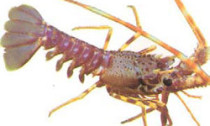
Lobsters, like shrimps and crabs, are decapods – literally meaning 10 legs – and can be found in all of the world’s tropical and sub-tropical seas as well as more temperate waters. They are predatory, nocturnal animals with a vividly decorated coat. They are often numerous locally; they linger in crevices (with their long antennae sticking out) during the day and hunt small benthic organisms at night, but they also feed on organic detritus whenever they happen across it. As with all crustaceans, the lobster moults or sheds its shell to grow.
Lobsters have recently suffered a dramatic demographic decline; intensive fishing has annihilated entire populations, especially where tourism abounds.
The lobster families that you may encounter are the spiny rock lobsters, Palinuridae and the slipper lobsters, Scyllaridae and one species of the true reef lobsters, Nephropidae.
The true reef lobsters, Nephropidae, with their enlarged pincers on the first pair of legs, tend to prefer warmer waters, but the European lobster (Homarus gammarus) can be found in the region, on rocky substrata, living in holes and excavated tunnels from the lower shore to about 60m depth. This is a large lobster that can grow up to one metre in length, although 50 cm is more common. It is blue-coloured above with coalescing spots and yellowish below. The first pair of walking legs carry large buts slightly unequal pincers that can be both formidable and dangerous
The Palinurus genus (frequently transcribed as Panulirus) is represented by numerous species in all of the world’s tropical and sub-tropical seas as well as more temperate waters. It is a predatory, nocturnal animal with a vividly decorated coat. Among the species that you may encounter in these waters is the pink spiny lobster (Palinurus mauritanicus) and the crayfish (Palinurus elephas), with its orange colouration and two long antennae.
Scyllarus arctus is a warm water species found in the Mediterranean, and in the Eastern Atlantic They live on stony ground, in caves, and can also be found on muddy bottoms or in seagrass beds. They use the large spade-like scales at the front of the head to burrow into mud, sand or gravel between and under stones. This crustacean can grow to 16cm long, is dark brown, with a lobster-like tail. It lacks the large claws of a true lobster, or the long antennae of spiny lobster. Instead it sports very short antennae and two large hinged scales or plates at the front of the shell. The carapace has a rough consistency. The head scales have an attractive light and dark brown pattern and there are light brown and red markings on the tail. The walking legs have alternating bands of cream and brown.








Social Profiles